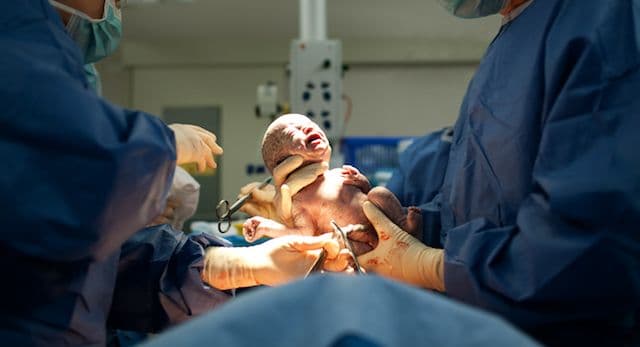Cesarean Section and Delivery
Cesarean Delivery
Obie Editorial Team

A cesarean delivery or cesarean section is a medical procedure where a baby is delivered through an incision made in the mother's abdomen and uterus. This approach ensures the safe birth of the baby when a vaginal delivery poses potential risks to the mother or child.
In the United States, about one in three babies arrive via cesarean section—a statistic that has maintained stability for a decade. This operative delivery, or C-section, offers a vital option when swift or safer delivery methods are necessary, particularly for those with previous cesarean experiences. Approximately one-third of all C-sections involve repeat procedures. A cesarean section is chosen in scenarios where vaginal childbirth may endanger the well-being of mom or baby, shifting the decision towards a safer alternative for both parties. Take a moment to explore more about cesarean sections.
When is a C-section Necessary?
A significant proportion of C-sections—around 80%—are performed for specific reasons, including:
- Repeat cesarean section
- Abnormal labor progress
- Non-reassuring fetal status (sometimes referred to as "fetal distress")
- Breech presentation (baby positioned with head up, buttocks or feet down)
Additional factors that might warrant a cesarean delivery include premature infants, placenta previa, abruptio placentae, high blood pressure, a larger baby, or other medical complications.
Having a C-section doesn’t dictate future births. Your journey can include considering a Vaginal Birth After Cesarean (VBAC), a conversation to have proactively with your healthcare provider based on your unique circumstances.
Indicators for a Cesarean Section
Before Labor
- Preference for a repeat cesarean after a previous procedure
- History of a cesarean with a vertical uterine incision or other uterine surgeries
- Presence of placenta previa
- Baby in breech or transverse positions
- Concerns of a baby being too large for a vaginal birth
- Signs of fetal distress or if the infant is not tolerating labor
- Multiple gestations (such as triplets or more)
- Existing medical conditions that contraindicate labor
- Obstructions such as fibroids or ovarian tumors
- Active infections like herpes or HIV
During Labor
- Potential fetal compromise: Signs the baby is not coping with labor (abnormal fetal tracings)
- Development of urgent complications such as abruptio placentae or preeclampsia necessitating rapid delivery
- Situations where the baby cannot pass through the pelvis (cephalopelvic disproportion, or CPD)
Types of Anesthesia for a Cesarean Section
Regional anesthesia, commonly in the form of spinal or epidural, is frequently employed during C-sections. This allows you to remain awake, participatory in your childbirth experience while ensuring effective pain management.
The choice between an epidural and spinal anesthesia involves consideration of control and flexibility. Epidurals offer adjustable pain relief, while spinal anesthesia provides a one-time pain block, often used for emergencies due to its quick, profound effectiveness.
Sometimes, should complications arise, general anesthesia may be necessary, ensuring swift response while slightly increasing risk factors during and after the procedure. Familiarize yourself with unique birthing experiences.
Performing a Cesarean Delivery: The Step-by-Step Process
During a C-section, a horizontal cut is made across the lower abdomen, just below the "bikini line," known as a "Pfannenstiel incision." This gives access to the uterus through layers of muscle, fat, and connective tissue until the baby's amniotic sac is reached. Once opened, the baby is gently delivered through this incision, promptly introduced to parents before receiving immediate care.
Focus then shifts to the mother’s well-being: the placenta is removed, and the uterus is cleansed. Closure involves suturing the uterus, abdominal muscles, and skin with precision to ensure a smooth, hidden recovery scar.
While C-sections are major surgical procedures, they inherently carry safety and health protocols to minimize risks. Fathers typically remain with mothers, separated by a drape, involved in this extraordinary process.
Post-surgery, uterine recovery is expedited using intravenous medication, which can lead to cramping sensations indicative of healing.
Recovering Post-Cesarean
Recovery after a C-section generally lasts about six weeks, with nuances based on individual health and activity levels. Pain management, through medications, plays a crucial role in helping new mothers bond with their babies. Hospital stays extend an average of 3-4 days post-operation, ensuring stability before discharge.
At home, adapting activities by minimizing heavy lifting and encouraging gentle walking positively impacts recovery. Early mobilization, like short, manageable walks, is encouraged within hours of surgery to promote healing and prevent complications.
Discover essential insights on preparing for a cesarean delivery, VBAC options, and indications for cesarean sections.



